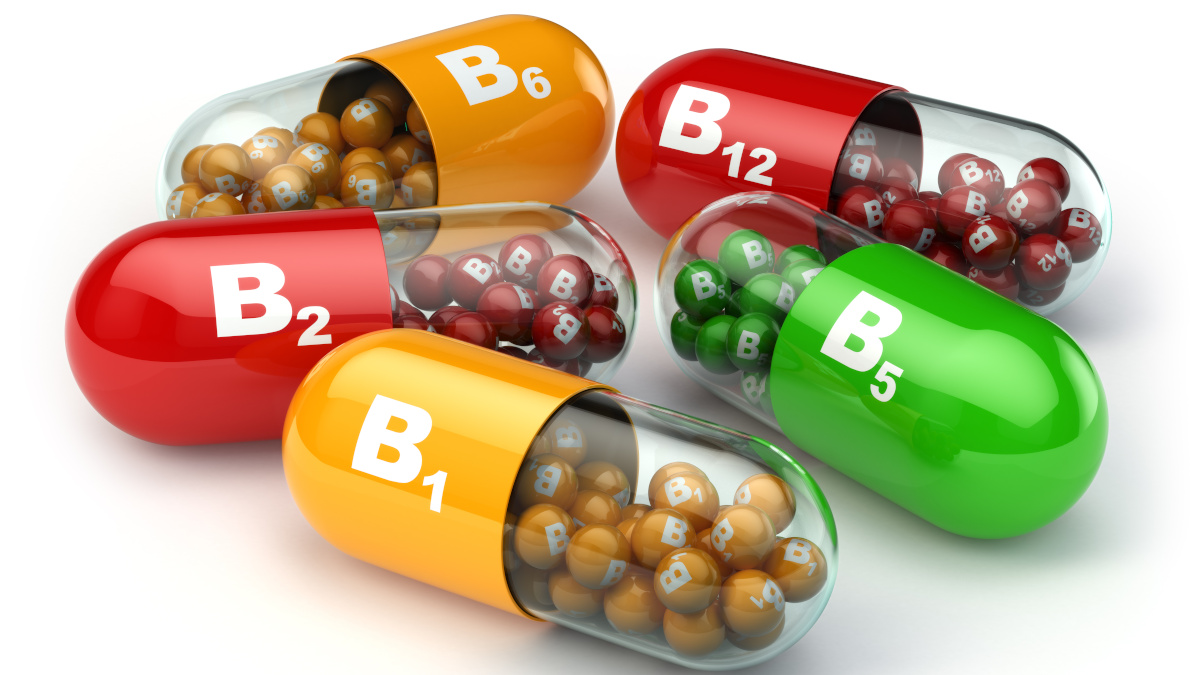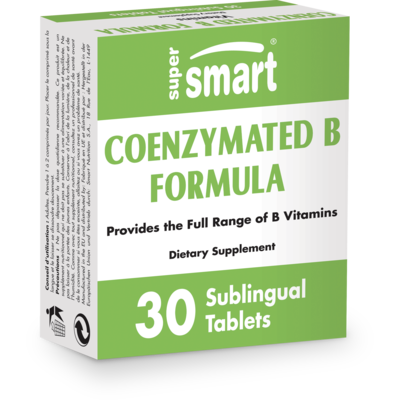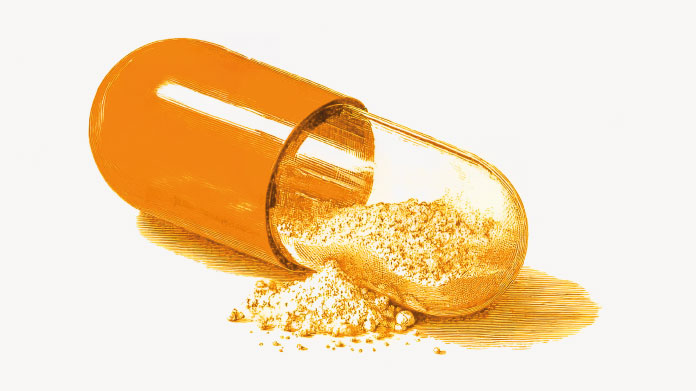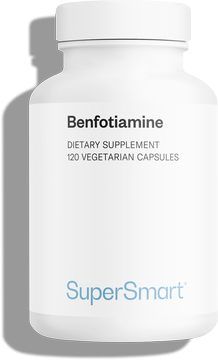What are the benefits of the B vitamins?
Numbering eight in total, the B group vitamins play an essential role in maintaining our vital functions. Get up to speed with their benefits with this comprehensive guide.

B vitamins B: a big family!
The group of B vitamins comprises 8 water-soluble vitamins, each with its own number: B1, B2, B3, B5, B6, B8, B9, and B12 (1). Though chemically very different, they share certain functional similarities.
Acting as coenzymes of many biological reactions, the B vitamins play a synergistic role in all metabolic and energy pathways (converting nutrients into energy) (2). Some also have a free radical-fighting (antioxidant) effect. They are in fact essential for normal functioning of the body.
As we are unable to produce and/or store B vitamins in the amounts necessary for our needs, any surplus being eliminated via the urinary tract, we need to obtain a regular supply from the diet (3).
B vitamins and their benefits in detail
Vitamin B1 (thiamine)
Absorbed in the jejunum (the middle part of the small intestine), vitamin B1 or thiamine is primarily concentrated in the liver, muscles, kidneys, and nervous system (4).
Converted in the liver into its active form, thiamine pyrophosphate, it supports normal energy metabolism by ensuring the conversion of carbohydrates into energy, as well as the breakdown of certain amino acids (valine, leucine, isoleucine) (5).
It also helps to maintain normal nervous system and heart function and psychological function. It is thought to be involved in, amongst others, the production of acetylcholine, a neurotransmitter integral to memory and learning processes as well as muscle activity (6).
Vitamin B2 (riboflavin)
Also known as riboflavin or lactoflavin, vitamin B2, like thiamine, supports normal nervous system function and energy metabolism, though by affecting macronutrients as a whole (proteins, carbohydrates and fats) (7).
Acting in tandem with vitamins B3 and B6, it is also a component of two redox coenzymes (FMD and FAD), and thus plays a role in protecting cells against oxidative stress (8).
Highly-concentrated in the retina, it helps ensure healthy vision, especially in low light situations (9). It also helps maintain normal skin by contributing to keratin production.
As it is involved in iron metabolism, vitamin B2 also plays a role in maintaining healthy red blood cells and thus helps reduce fatigue by ensuring good tissue oxygenation (10).
Vitamin B3 (niacin)
Discovered during experiments on nicotine, vitamin B3 used to be known as nicotinic acid before being renamed niacin. It is also known as vitamin PP (pellagra-preventive), as deficiency in this vitamin can lead to the condition known as pellagra (11).
Like its cousins, vitamin B3 helps maintain normal energy metabolism, with a special affinity for the breakdown of fats. In particular, it acts as a precursor of NAD and NADP, two coenzymes which govern cellular energy production and fat molecule synthesis (12).
Playing a role in healthy nervous system function, it may have a protective effect on neuronal cells (13).
Vitamin B5 (pantothenic acid)
From the Greek pantos (meaning ‘from everywhere’), pantothenic acid, or vitamin B5, is found in almost all living organisms. Once absorbed, it is converted into its biologically active form, coenzyme A (14).
Vitamin B5 supports healthy energy metabolism, with a particular role in breaking down fats. It also supports normal production of steroid hormones, vitamin D and certain neurotransmitters (such as adrenaline) (15).
Its effect on the adrenal glands also explains why it is able to help reduce fatigue (16).
Vitamin B6
Present in food in various forms, vitamin B6 is bioactive in the form of pyridoxal-5-phosphate (PLP) (17).
Involved in the enzymatic conversion of many amino acids, vitamin B6 plays a role, amongst others, in the:
- Normal metabolism of glycogen and proteins (18) ;
- Normal metabolism of homocysteine and synthesis of cysteine (19) ;
- Normal function of the nervous system (through endogenous synthesis of various neurotransmitters: adrenaline, GABA…) (20) ;
- Normal formation of red blood cells (role in haemoglobin synthesis) (21) ;
- Normal function of the immune system (close link with antibody production and release of histamine) (22) ;
- Reduction of fatigue (23).
Vitamin B8 (biotin)
Sometimes referred to as vitamin H or coenzyme R, vitamin B8 (biotin) plays a role in the metabolism of all macronutrients by facilitating the mobilisation of fats, the conversion of sugars into glucose, and the synthesis of amino acids (24). Produced by our gut flora, the fact that it is eliminated via urine means we need to ensure an adequate supply from the diet.
Much in demand in the cosmetics field, biotin helps maintain normal hair and skin by promoting cell renewal (25). With an interdependent relationship with vitamins B9 and B12, it also supports good nervous system function (26).
Vitamin B9 (folate)
Vitamin B9 (folic acid or folate) plays a major role in cell division and supports normal synthesis of amino acids(27). It is crucial for pregnant women as it is involved in normal maternal tissue growth during pregnancy. A lack of folate in the pre-conception period significantly raises the risk of neural tube defects in the foetus (28).
It is also involved in forming normal red blood cells by allowing them to mature, as well as in normal immune system function by supporting production of white blood cells (29).
It has also been shown to help maintain normal psychological function and reduce fatigue (30).
Vitamin B12 (cobalamin)
Found only in animal-source products, vitamin B12 is one of the few B vitamins that the body is able to store in significant quantities (primarily in the liver, pancreas, brain, and heart) (31).
It has direct role in ensuring good nervous system function as it is a component of the myelin sheaths which surround nerve cells and enable the transmission of nerve signals (32).
In conjunction with vitamin B9, it supports normal formation of red blood cells and helps maintain normal immune system function, as well as being involved in cell division (production of genetic material) (33).
What about the others?
You will have noticed that the the numbering of the B vitamins is not sequential. The strange gaps in the nomenclature are because certain substances once thought to be vitamins were later found not to be.
Vitamin B4, used to correspond to adenine, is now associated with choline. B10 refers topara aminobenzoic acid(PABA), while B11 used to refer to folic acid (B9).
Vitamin B7 is a little different: in some English-speaking countries and in Germany, it remains the term used for biotin (vitamin B8).
Which B vitamin complex should you choose?
If you would like to supplement with vitamin B, opt for a complex that contains forms offering excellent absorbability and uptake.
The coenzymated versions, already in an active form, should be your first choice: unlike the free forms, they do not need to go through any digestive stages in order to be activated.
For optimal efficacy, however, they need to be taken sublingually in order to bypass the digestive tract and avoid being reconverted into the free form (one such product is Coenzymated B Formula, which combines the 8 active forms of vitamin B in a single, sublingual tablet).
SuperSmart ADVICE
References
- LiverTox: Clinical and Research Information on Drug-Induced Liver Injury [Internet]. Bethesda (MD): National Institute of Diabetes and Digestive and Kidney Diseases; 2012-. Vitamin B. [Updated 2021 May 27]. Available from: https://www.ncbi.nlm.nih.gov/books/NBK548710/
- Lyon P, Strippoli V, Fang B, Cimmino L. B Vitamins and One-Carbon Metabolism: Implications in Human Health and Disease. 2020 Sep 19;12(9):2867. doi: 10.3390/nu12092867. PMID: 32961717; PMCID: PMC7551072.
- Ford TC, Downey LA, Simpson T, McPhee G, Oliver C, Stough C. The Effect of a High-Dose Vitamin B Multivitamin Supplement on the Relationship between Brain Metabolism and Blood Biomarkers of Oxidative Stress: A Randomized Control Trial. 2018 Dec 1;10(12):1860. doi: 10.3390/nu10121860. PMID: 30513795; PMCID: PMC6316433.
- Martel JL, Kerndt CC, Doshi H, et al. Vitamin B1 (Thiamine) [Updated 2021 Oct 16]. In: StatPearls [Internet]. Treasure Island (FL): StatPearls Publishing; 2022 Jan-. Available from: https://www.ncbi.nlm.nih.gov/books/NBK482360/
- Pácal L, Kuricová K, Kaňková K. Evidence for altered thiamine metabolism in diabetes: Is there a potential to oppose gluco- and lipotoxicity by rational supplementation? World J Diabetes. 2014 Jun 15;5(3):288-95. doi: 10.4239/wjd.v5.i3.288. PMID: 24936250; PMCID: PMC4058733.
- Calderón-Ospina CA, Nava-Mesa MO. B Vitamins in the nervous system: Current knowledge of the biochemical modes of action and synergies of thiamine, pyridoxine, and cobalamin. CNS Neurosci Ther. 2020 Jan;26(1):5-13. doi: 10.1111/cns.13207. Epub 2019 Sep 6. PMID: 31490017; PMCID: PMC6930825.
- Mahabadi N, Bhusal A, Banks SW. Riboflavin Deficiency. [Updated 2022 Jul 18]. In: StatPearls [Internet]. Treasure Island (FL): StatPearls Publishing; 2022 Jan-. Available from: https://www.ncbi.nlm.nih.gov/books/NBK470460/
- Ashoori M, Saedisomeolia A. Riboflavin (vitamin B₂) and oxidative stress: a review. Br J Nutr. 2014 Jun 14;111(11):1985-91. doi: 10.1017/S0007114514000178. Epub 2014 Mar 20. PMID: 24650639.
- Genc AM, Makia MS, Sinha T, Conley SM, Al-Ubaidi MR, Naash MI. Retbindin: A riboflavin Binding Protein, Is Critical for Photoreceptor Homeostasis and Survival in Models of Retinal Degeneration. Int J Mol Sci. 2020 Oct 29;21(21):8083. doi: 10.3390/ijms21218083. PMID: 33138244; PMCID: PMC7662319.
- Hassan RM, Thurnham DI. Effect of riboflavin deficiency on the metabolism of the red blood cell. Int J Vitam Nutr Res. 1977;47(4):349-55. PMID: 591205.
- Redzic S, Gupta V. Niacin Deficiency. [Updated 2022 May 23]. In: StatPearls [Internet]. Treasure Island (FL): StatPearls Publishing; 2022 Jan-. Available from: https://www.ncbi.nlm.nih.gov/books/NBK557728/
- Peechakara BV, Gupta M. Vitamin B3. [Updated 2022 Jun 11]. In: StatPearls [Internet]. Treasure Island (FL): StatPearls Publishing; 2022 Jan-. Available from: https://www.ncbi.nlm.nih.gov/books/NBK526107/
- Gasperi V, Sibilano M, Savini I, Catani MV. Niacin in the Central Nervous System: An Update of Biological Aspects and Clinical Applications. Int J Mol Sci. 2019 Feb 23;20(4):974. doi: 10.3390/ijms20040974. PMID: 30813414; PMCID: PMC6412771.
- Sanvictores T, Chauhan S. Vitamin B5 (Pantothenic Acid) [Updated 2022 Apr 6]. In: StatPearls [Internet]. Treasure Island (FL): StatPearls Publishing; 2022 Jan-. Available from: https://www.ncbi.nlm.nih.gov/books/NBK563233/
- Pan L, Jaroenporn S, Yamamoto T, Nagaoka K, Azumano I, Onda M, Watanabe G, Taya K. Effects of pantothenic acid supplement on secretion of steroids by the adrenal cortex in female rats. Reprod Med Biol. 2011 Dec 2;11(2):101-104. doi: 10.1007/s12522-011-0113-6. PMID: 29699114; PMCID: PMC5906947.
- Gheita AA, Gheita TA, Kenawy SA. The potential role of B5: A stitch in time and switch in cytokine. Phytother Res. 2020 Feb;34(2):306-314. doi: 10.1002/ptr.6537. Epub 2019 Nov 5. PMID: 31691401.
- Abosamak NER, Gupta V. Vitamin B6 (Pyridoxine) [Updated 2022 May 23]. In: StatPearls [Internet]. Treasure Island (FL): StatPearls Publishing; 2022 Jan-. Available from: https://www.ncbi.nlm.nih.gov/books/NBK557436/
- Parra M, Stahl S, Hellmann H. Vitamin B₆ and Its Role in Cell Metabolism and Physiology. 2018 Jul 22;7(7):84. doi: 10.3390/cells7070084. PMID: 30037155; PMCID: PMC6071262.
- Miodownik C, Lerner V, Vishne T, Sela BA, Levine J. High-dose vitamin B6 decreases homocysteine serum levels in patients with schizophrenia and schizoaffective disorders: a preliminary study. Clin Neuropharmacol. 2007 Jan-Feb;30(1):13-7. doi: 10.1097/01.WNF.0000236770.38903.AF. PMID: 17272965.
- Guilarte TR. Vitamin B6 and cognitive development: recent research findings from human and animal studies. Nutr Rev. 1993 Jul;51(7):193-8. doi: 10.1111/j.1753-4887.1993.tb03102.x. PMID: 8414222.
- Brown MJ, Ameer MA, Beier K. Vitamin B6 Deficiency. [Updated 2022 Jul 18]. In: StatPearls [Internet]. Treasure Island (FL): StatPearls Publishing; 2022 Jan-. Available from: https://www.ncbi.nlm.nih.gov/books/NBK470579/
- Rall LC, Meydani SN. Vitamin B6 and immune competence. Nutr Rev. 1993 Aug;51(8):217-25. doi: 10.1111/j.1753-4887.1993.tb03109.x. PMID: 8302491.
- Heap LC, Peters TJ, Wessely S. Vitamin B status in patients with chronic fatigue syndrome. J R Soc Med. 1999 Apr;92(4):183-5. doi: 10.1177/014107689909200405. PMID: 10450194; PMCID: PMC1297139.
- Yudkoff M. Biotin Metabolism. In: Siegel GJ, Agranoff BW, Albers RW, et al., editors. Basic Neurochemistry: Molecular, Cellular and Medical Aspects. 6th edition. Philadelphia: Lippincott-Raven; 1999. Available from: https://www.ncbi.nlm.nih.gov/books/NBK28072/
- McCarty MF, DiNicolantonio JJ. Neuroprotective potential of high-dose biotin. Med Hypotheses. 2017 Nov;109:145-149. doi: 10.1016/j.mehy.2017.10.012. Epub 2017 Oct 16. PMID: 29150274.
- Guo X, Ni J, Zhu Y, Zhou T, Ma X, Xue J, Wang X. Folate deficiency induces mitotic aberrations and chromosomal instability by compromising the spindle assembly checkpoint in cultured human colon cells. 2017 Dec 31;32(6):547-560. doi: 10.1093/mutage/gex030. PMID: 29165592.
- Greenberg JA, Bell SJ, Guan Y, Yu YH. Folic Acid supplementation and pregnancy: more than just neural tube defect prevention. Rev Obstet Gynecol. 2011 Summer;4(2):52-9. PMID: 22102928; PMCID: PMC3218540.
- Merrell BJ, McMurry JP. Folic Acid. [Updated 2022 Apr 30]. In: StatPearls [Internet]. Treasure Island (FL): StatPearls Publishing; 2022 Jan-. Available from: https://www.ncbi.nlm.nih.gov/books/NBK554487/
- Ma F, Wu T, Zhao J, Song A, Liu H, Xu W, Huang G. Folic acid supplementation improves cognitive function by reducing the levels of peripheral inflammatory cytokines in elderly Chinese subjects with MCI. Sci Rep. 2016 Nov 23;6:37486. doi: 10.1038/srep37486. PMID: 27876835; PMCID: PMC5120319.
- Al Amin ASM, Gupta V. Vitamin B12 (Cobalamin) [Updated 2022 Jun 21]. In: StatPearls [Internet]. Treasure Island (FL): StatPearls Publishing; 2022 Jan-. Available from: https://www.ncbi.nlm.nih.gov/books/NBK559132/
- Wu F, Xu K, Liu L, Zhang K, Xia L, Zhang M, Teng C, Tong H, He Y, Xue Y, Zhang H, Chen D, Hu A. Vitamin B12 Enhances Nerve Repair and Improves Functional Recovery After Traumatic Brain Injury by Inhibiting ER Stress-Induced Neuron Injury. Front Pharmacol. 2019 Apr 24;10:406. doi: 10.3389/fphar.2019.00406. Erratum in: Front Pharmacol. 2021 Apr 12;12:598335. PMID: 31105562; PMCID: PMC6491933.
- Azzini E, Raguzzini A, Polito A. A Brief Review on Vitamin B12 Deficiency Looking at Some Case Study Reports in Adults. Int J Mol Sci. 2021 Sep 7;22(18):9694. doi: 10.3390/ijms22189694. PMID: 34575856; PMCID: PMC8471716.
Keywords
23 Hours
Ordering was easy and the product was…
Ordering was easy and the product was delivered with no problems. Appreciated that I was notified when it would arrive. Thanks!
MascarC
6 Days
Great customer service - responsive …
I ordered from them and my item was unavailable for sometime. I was super happy when they reactivated my order and shipped my item which arrived very quickly. Great customer service.
Ruth Rueter
7 Days
Super fast shipping
Super fast shipping
Donald Borling
10 Days
Reputable companysearch and the number of…
The research and the number of selection of products.
NAKHJAVAN Shervin
23 Days
The Anti Aromatase is a great product
The Anti Aromatase is a great product. You just need to have constant inventory. Recently this product has been out of stock.
GEORGE Verne
25 Days
Great help on chat
Great help on chat. Knowledgeable and friendly.
Jason Argos
28 Days
Customer service was fast and friendly.
Customer service helped to stop the transaction process of the subscription. I appreciated that.
Greenie
28 Days
I order here due to the high quality of…
I order here due to the high quality of the products and the quick delivery of items - thank you
Barbara J
30 Days
SuperSmart's Eye Pressure supplements: highly recommended!
I purchase SuperSmart's Eye Pressure supplements regularly for over 5 years, and gotta say they are truly a wonderful product for my Glaucoma. Highly recommended if you have eye pain from your Glaucoma.
D. Martinez
34 Days
Quick service
Quick service
MONELL
35 Days
Speedy service.
Speedy service.
ROSENTHAL Marvin
39 Days
Clear website- Efficient
Clear website. Excellent search engine and fast delivery!
Mohamad Hussein
41 Days
They have great products.
They have great products.
Vickie
41 Days
Great Shipping Time!
You Have A Great Shipping Time! Praise The Lord!
DMHoge
43 Days
Doctor Recommended!
Good pricing, very good availability, doctor recommended (couldn't find what I needed anywhere else), and it took only a week to arrive (which I can't complain about).
Al






